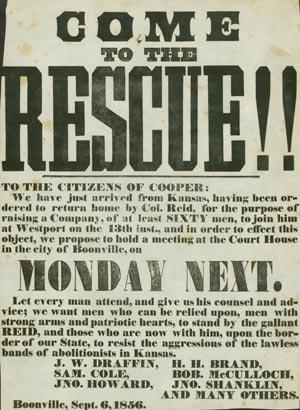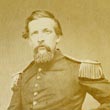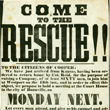The Civil War in Missouri
Save ThisMy CollectionKansas-Nebraska Act: Bleeding Kansas

Highlights
- In 1854, Senator Stephen Douglas introduced a bill before Congress for the organization of Kansas and Nebraska (Kansas-Nebraska Act). The territories would be divided by the 40th parallel.
- In addition, the issue of slavery in the territories would be decided by popular sovereignty instead of by the Missouri Compromise of 1820.
- Despite fierce opposition in the North by such abolitionists as Horace Greeley and William Lloyd Garrison, the bill passed on May 26, 1854, and was quickly signed by President Franklin Pierce.
- Northern abolitionists were not done fighting, however. They began organizing groups for the settlement of Kansas Territory to combat western Missourians who were by and large pro-slavery and had begun moving into the area.
In-Depth
In 1854, Senator Stephen Douglas introduced a bill before Congress for the organization of two territories, Kansas and Nebraska. The territories would be divided by the 40th parallel. In addition, the issue of slavery in the territories would be decided by popular sovereignty instead of by the Missouri Compromise of 1820. Despite fierce opposition in the North by such abolitionists as Horace Greeley and William Lloyd Garrison, the bill passed on May 26, 1854, and was quickly signed by President Franklin Pierce.
Southern newspapers rejoiced that the territories had been opened to settlement for Southerners and their slaves. Northern abolitionists were not done fighting however. They began organizing groups for the settlement of Kansas Territory to combat western Missourians who were by and large pro-slavery and had begun moving into the area. The best organized of these efforts was the Emigrant Aid Company of Massachusetts, also known as the New England Emigrant Aid Company. This organization, led by wealthy abolitionists, helped anti-slavery settlers move to Kansas. Anti-slavery settlers helped to found the cities of Topeka and Lawrence, while the cities of Atchison and Leavenworth were settled primarily by pro-slavery Missourians.
Violence
Highlights
- Violence between pro-slavery and anti-slavery settlers began early on. The anti-slavery settlers became known as Jayhawkers, and the many pro-slavery forces that crossed over from Missouri became known as Border Ruffians.
- While the total number of deaths was relatively small (roughly 50 deaths from 1854 to 1859) the tension between the two factions was very real and intense.
- The newspapers in the East dramatized the violence in Kansas.
- The bulk of violence in Kansas resulted from conflict over land claims or attacks on individuals.
In-Depth
Violence between pro-slavery and anti-slavery settlers began early on. The anti-slavery settlers became known as Jayhawkers, and the many pro-slavery forces who crossed over from Missouri became known as Border Ruffians. While the total number of deaths was small (roughly 50 deaths from 1854 to 1859) the tension between the two factions was very real and intense. The newspapers in the East dramatized the violence a great deal. The so-called Wakarusa War of November–December 1855 is a striking example. It began when an anti-slavery settler was shot by a pro-slavery man over a land claim. This event set off an escalation of tensions.
Sheriff Jones of Douglas County asked the governor for help in putting down the “lawless action” and contacted his father-in-law, Colonel Daniel Boone in Missouri. Alarmed, the residents of Lawrence began to fortify the city, and free-state militia units began to arrive from across the state. Pro-slavery militia soon arrived and surrounded the city. The siege of Lawrence ended when James Lane and Charles Robinson negotiated a truce with the governor. This whole event resulted in the loss of only one life, but fed anger and militancy.
Most of the violence in Kansas was not as large in scale as the siege of Lawrence. The bulk of it was merely conflict over land claims or attacks on individuals. For example, in May of 1855 Cole McCrea killed pro-slavery Malcolm Clark over an argument over a claim in Salt Creek. In another instance, Reverend Pardee Butler was escorted out of Atchison by a committee of citizens for refusing to sign a memorial for a Border Ruffian. They then painted an R for Republican on his forehead, lashed him to a raft, and shoved him out into the Missouri River. He was eventually saved from the river.
The chaos on the border led to the Missouri Volunteer Militia to dispatch a battalion known as the Southwest Expedition to partol the state border. John S. Bown was commander of this unit. He later became a General in the Confederate Army.
Government
Highlights
- The conflict between pro-slavery and anti-slavery individuals made governing the Kansas Territory difficult.
- The first election of legislators was taken over by illegal voters from Missouri, who elected a pro-slavery legislature.
- The conflict over elections resulted in two separate governments operating inside of Kansas, a pro-slavery one and an anti-slavery one. In 1859 a single constitution was finally adopted.
In-Depth
The conflict between pro-slavery and anti-slavery individuals made governing the Kansas Territory difficult. The first election of legislators was taken over by illegal voters from Missouri, who elected a pro-slavery legislature. The conflict over elections resulted in two separate governments operating inside of Kansas, a pro-slavery one and an anti- slavery one. The anti-slavery government formed in Topeka and was declared by a congressional investigating committee to be representative of the majority of Kansas citizens.
Regardless of this finding, pro-slavery delegates still met in Lecompton in 1857 and drafted a constitution. Kansas residents voted on the constitution in January of 1858. Because of a boycott by free-state supporters the constitution passed. In February of 1858 the U.S. government intervened and determined to have another election in Kansas. The result of that election in August of 1858 was the final defeat of the Lecompton Constitution.
Aftermath and Effects
Highlights
- The fierce animosity that had fed violence in Kansas and Missouri continued and impacted how the Civil War was fought on the Missouri-Kansas border.
- In addition, the atmosphere in Kansas, and the media’s portrayal, spurred tensions nationally and was one of the events that helped to bring on the Civil War.
- “Bleeding Kansas” can be seen as both a foreshadowing and a microcosm of the Civil War. As historian Alice Nichols wrote, “Kansas had a twin and its twin was the Civil War.”
In-Depth
In 1859, a final constitution was adopted. However, the fierce animosity that had fed violence in Kansas and Missouri continued and impacted how the Civil War was fought on the Missouri-Kansas border. Many of the guerillas who roamed southwest Missouri had been brought to violence by the conflict of Bleeding Kansas and the border wars with Missouri. In addition, the atmosphere in Kansas, and the media’s portrayal, spurred tensions nationally and was one of the events that helped to bring on the Civil War.
Bleeding Kansas can be seen as both a foreshadowing and a microcosm of the Civil War. As historian Alice Nichols wrote, “Kansas had a twin and its twin was the Civil War.”
Primary Sources

